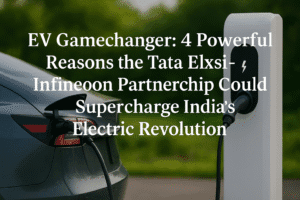EV Gamechanger: 4 Powerful Reasons the Tata Elxsi-Infineon Partnership Could Supercharge India’s Electric Revolution
Strategic Collaboration for India’s EV Surge: Tata Elxsi and Infineon are partnering to co-develop ready-to-deploy EV subsystems, directly tackling India’s urgent need for affordable, safe, and locally relevant electric mobility solutions. By combining Tata’s system integration expertise with Infineon’s advanced semiconductors like silicon carbide (SiC), they’ll deliver critical components – including high-voltage inverters, scalable BMS, and bi-directional chargers – tailored for India’s booming two-wheeler, three-wheeler, and commercial vehicle segments.
Crucially, the partnership prioritizes functional safety (ASIL-D compliance) to address critical concerns like battery fires. This collaboration aims to drastically shorten development cycles for Indian OEMs, enhance supply chain resilience, and support ambitious national electrification targets. Ultimately, it’s a calculated move to position India as a blueprint for efficient, scalable EV adoption in cost-sensitive emerging markets.

EV Gamechanger: 4 Powerful Reasons the Tata Elxsi-Infineon Partnership Could Supercharge India’s Electric Revolution
India’s electric vehicle (EV) surge isn’t just about flashy cars or subsidies—it hinges on solving gritty engineering challenges: affordability, localized tech, and safety. The newly announced collaboration between Tata Elxsi (design/engineering leader) and Infineon (semiconductor powerhouse) targets these pain points head-on. Here’s what it means for India’s EV ecosystem:
- Beyond “Semiconductors + Software”: A System-Level Solution
This isn’t a typical supplier deal. Infineon provides cutting-edge chips (like silicon carbide for efficiency), while Tata Elxsi integrates them into pre-validated, application-ready subsystems:
- High-voltage inverters (traction/auxiliary)
- Scalable battery management systems (BMS)
- Bidirectional chargers (enabling vehicle-to-grid)
- Thermal management (critical in India’s extreme climates)
Why it matters: Indian OEMs—especially in 2W/3W segments—often lack resources to develop these complex systems from scratch. “Ready-to-deploy” kits slash development cycles by 12–18 months, accelerating time-to-market.
- Targeting India’s High-Volume, High-Risk Segments
The focus on two-wheelers (28% YoY growth), three-wheelers, and commercial vehicles is strategic:
- Safety First: ASIL-D compliance (ISO 26262) addresses battery fires—a top consumer concern.
- Cost Optimization: Localized design avoids import taxes, making EVs viable for mass adoption.
- Scalability: Solutions work across low-cost 3W loaders and premium e-cars, future-proofing R&D spend.
- The Unspoken Advantage: Supply Chain Resilience
Infineon’s “early access” pledge ensures Tata Elxsi—and thus Indian OEMs—gets priority on semiconductors. This mitigates supply chain bottlenecks that stalled global auto production during the chip shortage.
- Beyond Vehicles: The Bigger Vision
The roadmap hints at eVTOLs (flying taxis) and energy systems, signaling a play for next-gen mobility. Bidirectional chargers align with India’s renewable energy push, turning EVs into grid-stabilizing assets.
The India Context: Why Timing Matters
With NITI Aayog targeting 80% electric 2W/3W and 70% electric CVs by 2030, this partnership bridges a critical gap: indigenous, industrial-grade tech. As Nambi Ganesh (Tata Elxsi) notes, it’s about “production-ready platforms,” not prototypes.
Challenges Ahead
- Affordability: Can scaled production meet India’s ultra-cost-sensitive market?
- Interoperability: Will systems work seamlessly with India’s fragmented charging infrastructure?
- Skill Gap: Training engineers on ASIL-D/SiC tech remains vital.
The Bottom Line
This collaboration isn’t just about faster inverters or better chips. It’s a strategic bet on India’s ability to leapfrog legacy auto systems by co-creating integrated solutions. If executed well, it could make India a blueprint for emerging markets wrestling with similar EV adoption barriers.
You must be logged in to post a comment.